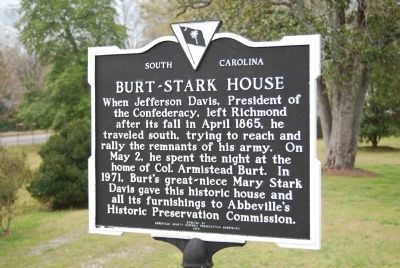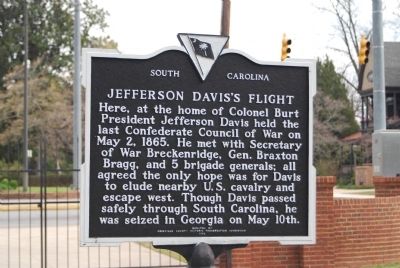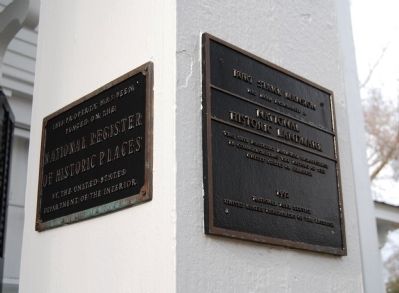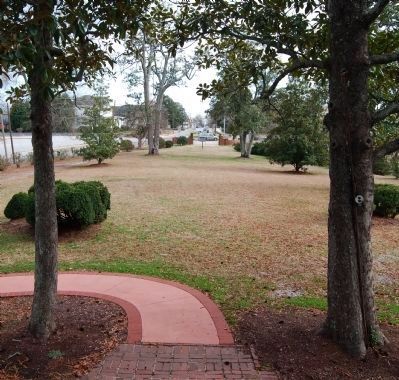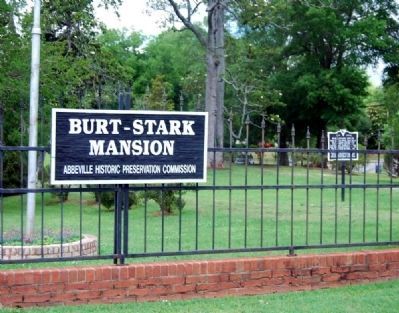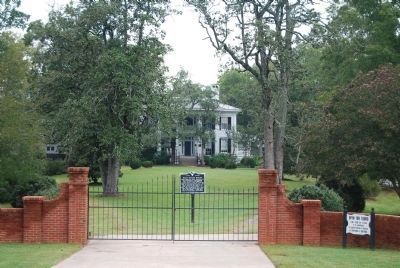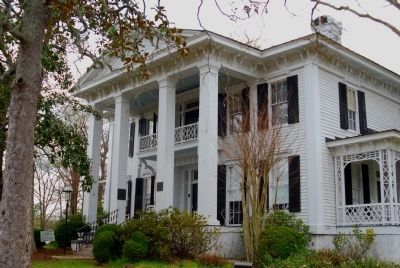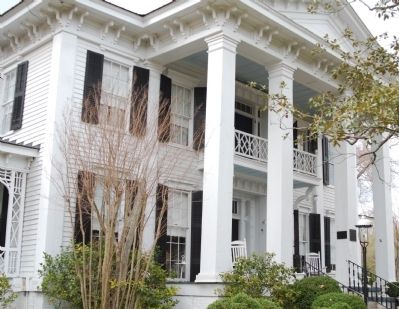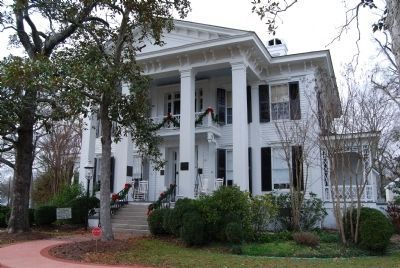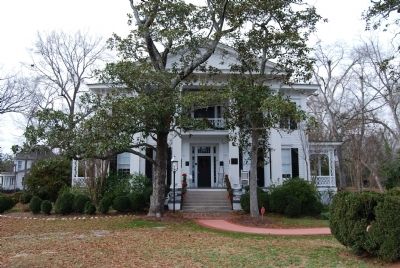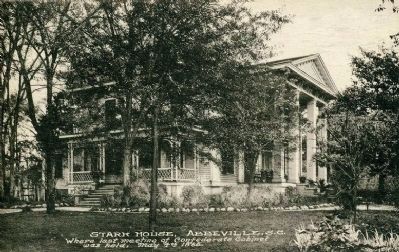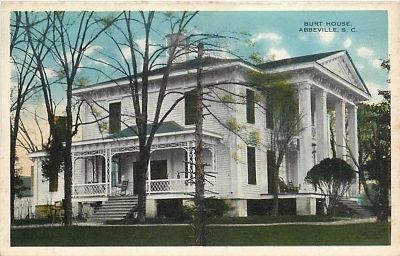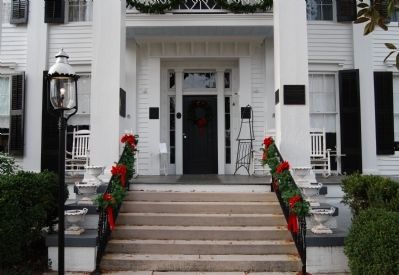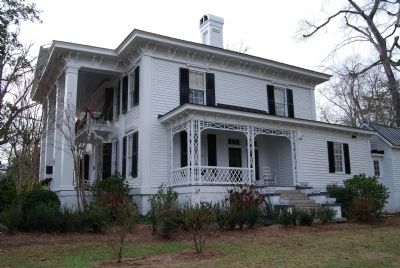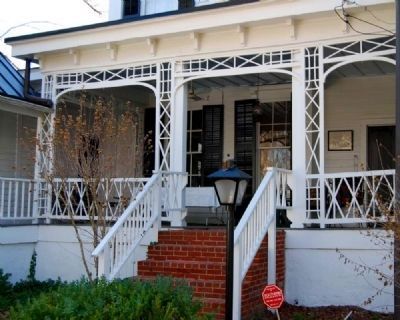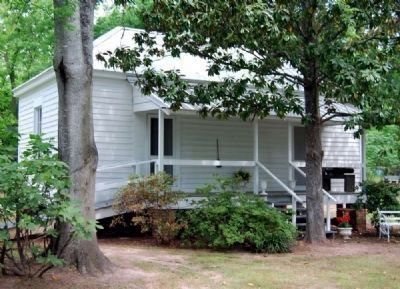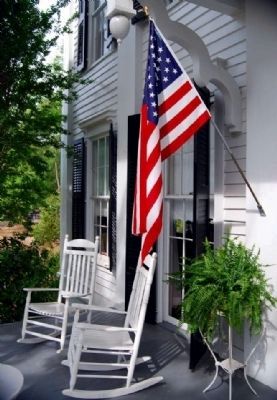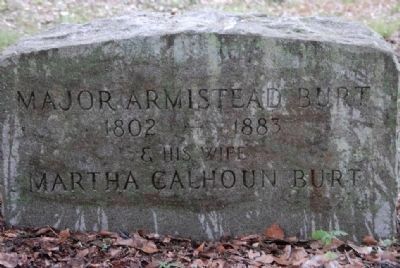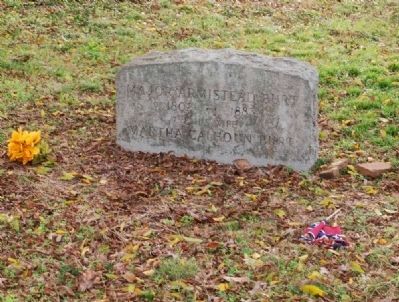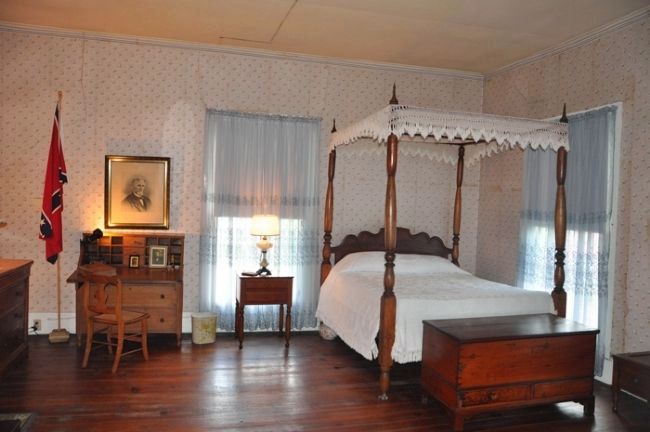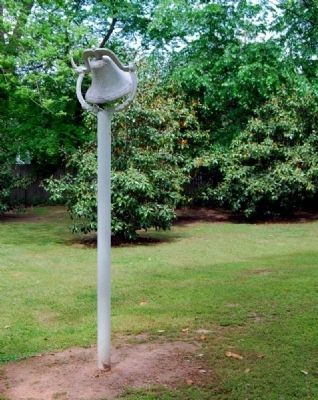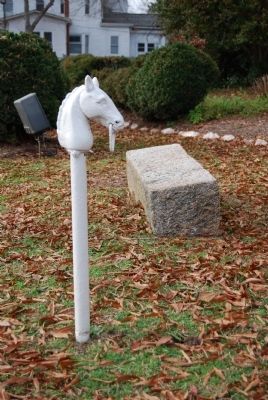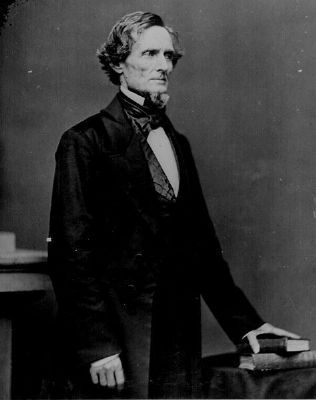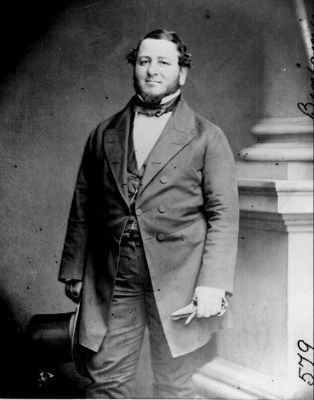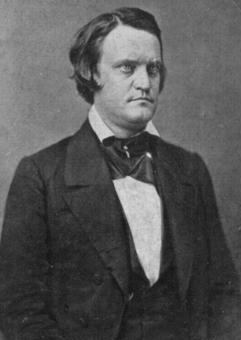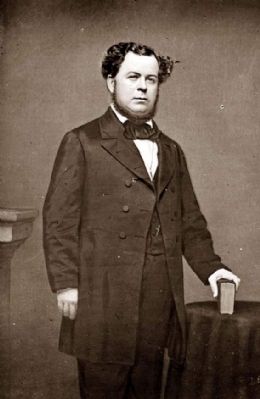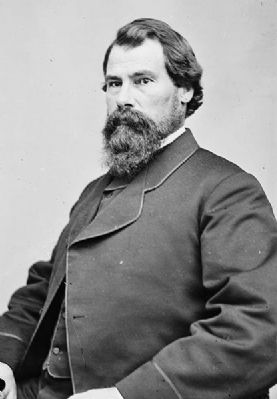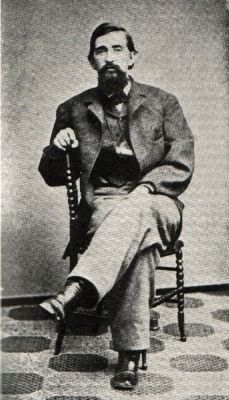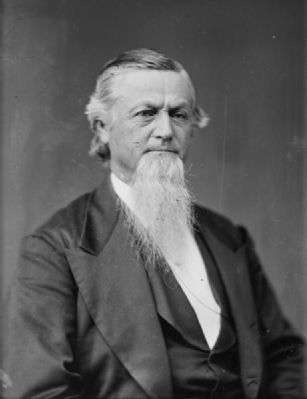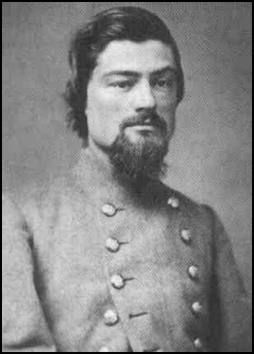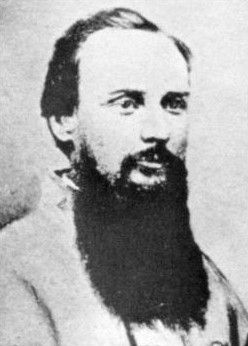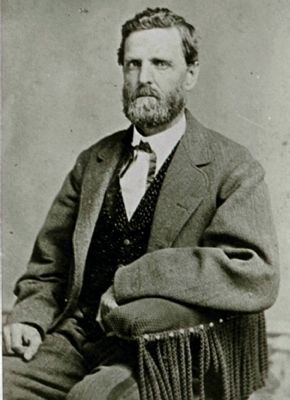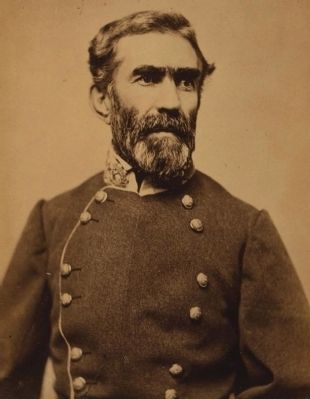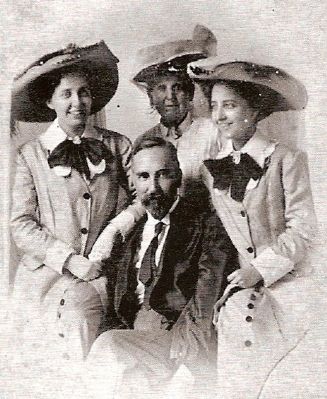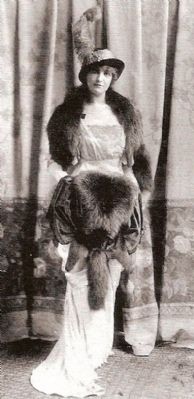Abbeville in Abbeville County, South Carolina — The American South (South Atlantic)
Burt-Stark House / Jefferson Davis’s Flight
Erected 1979 by Abbeville County Historic Preservation Commission. (Marker Number 1-7.)
Topics and series. This historical marker is listed in these topic lists: Settlements & Settlers • War, US Civil. In addition, it is included in the National Historic Landmarks, the South Carolina, Abbeville County Historical Society/Commission, and the South Carolina, Abbeville Historical Sites Tour series lists. A significant historical month for this entry is April 1865.
Location. 34° 10.833′ N, 82° 22.898′ W. Marker is in Abbeville, South Carolina, in Abbeville County. Marker is at the intersection of North Main Street (State Highway 71) and Greenville Street (State Highway 20) on North Main Street. Touch for map. Marker is at or near this postal address: 400 North Main Street, Abbeville SC 29620, United States of America. Touch for directions.
Other nearby markers. At least 10 other markers are within walking distance of this marker. The Last Meeting of the Confederate States Cabinet (within shouting distance of this marker); McGowan-Barksdale-Bundy House (about 300 feet away, measured in a direct line); Abbeville's Confederate Colonels (about 600 feet away); Thomas Chiles Perrin House (about 600 feet away); Maj. Thomas D. Howie (about 800 feet away); The Old Livery Stable (approx. ¼ mile away); Clarence E. Pressley (approx. ¼ mile away); Major Thomas Dry Howie (approx. ¼ mile away); Trinity Episcopal Church (approx. ¼ mile away); Abbeville Square (approx. ¼ mile away). Touch for a list and map of all markers in Abbeville.
Related markers. Click here for a list of markers that are related to this marker. These markers trace Davis' flight into Georgia and his subsequent arrest.
Also see . . .
1. Burt-Stark Mansion. The Burt-Stark Mansion, also known as Armistead Burt House, in Abbeville, South Carolina was the site of the last Council of War of cabinet members of the Confederate government. (Submitted on August 5, 2008, by Brian Scott of Anderson, South Carolina.)
2. Burt-Stark House. The Armistead Burt House is significant to Civil War history as it served as the location of President Jefferson Davis’ last Council of War. (Submitted on August 5, 2008, by Brian Scott of Anderson, South Carolina.)
3. Armistead Burt House. The Armistead Burt House is significant to Civil War history as it served as the location of President Jefferson Davis’ last Council of War. (Submitted on December 25, 2008, by Brian Scott of Anderson, South Carolina.)
4. The Burt-Stark House. SCETV video tour of the Burt-Stark Mansion. (Submitted on November 10, 2009, by Brian Scott of Anderson, South Carolina.)
5. Armistead Burt. Armistead Burt (November 13, 1802 - October 30, 1883) was a U.S. Representative from South Carolina. (Submitted on November 14, 2008, by Brian Scott of Anderson, South Carolina.)
6. Jefferson Davis. Jefferson Finis Davis (June 3, 1808 – December 6, 1889) was an American politician who served as President of the Confederate States of America for its entire history from 1861 to 1865 during the American Civil War. (Submitted on August 21, 2008, by Brian Scott of Anderson, South Carolina.)
7. Judah P. Benjamin. Judah Philip Benjamin (August 6, 1811 – May 6, 1884) was an American
politician and lawyer. (Submitted on May 4, 2009, by Brian Scott of Anderson, South Carolina.)
8. John Cabell Breckinridge. John Cabell Breckinridge (January 16, 1821 – May 17, 1875) was a lawyer, U.S. Representative, Senator from Kentucky, the 14th Vice President of the United States, Southern Democratic candidate for President in 1860, a Confederate general in the American Civil War, and the last Confederate Secretary of War. (Submitted on May 4, 2009, by Brian Scott of Anderson, South Carolina.)
9. Stephen Russell Mallory. Stephen Russell Mallory (1813 – November 9, 1873) was a United States politician and the Confederate Secretary of the Navy during the American Civil War. (Submitted on May 4, 2009, by Brian Scott of Anderson, South Carolina.)
10. John Henninger Reagan. John Henninger Reagan (October 8, 1818 – March 6, 1905), was a leading 19th century American politician from the U.S. state of Texas. (Submitted on May 4, 2009, by Brian Scott of Anderson, South Carolina.)
11. William Campbell Preston Breckinridge. William Campbell Preston Breckinridge (August 28, 1837 - November 18, 1904) was a Democratic U.S. Representative from Kentucky, a Member of the Masonic Lodge, and a Member of the Knights Templar. (Submitted on May 4, 2009, by Brian Scott of Anderson, South Carolina.)
12. Basil Wilson Duke. Basil Wilson
Duke (May 28, 1838 – September 16, 1916) was a Confederate general officer during the American Civil War. (Submitted on May 4, 2009, by Brian Scott of Anderson, South Carolina.)
13. George Gibbs Dibrell. George Gibbs Dibrell (April 12, 1822 – May 9, 1888) was an American lawyer and a five-term member of the United States House of Representatives from the 3rd Congressional District of Tennessee. (Submitted on May 4, 2009, by Brian Scott of Anderson, South Carolina.)
14. Braxton Bragg. Braxton Bragg (March 22, 1817 – September 27, 1876) was a career United States Army officer, and then a General in the Confederate States Army, a principal commander in the Western Theater of the American Civil War. (Submitted on May 4, 2009, by Brian Scott of Anderson, South Carolina.)
Additional commentary.
1. Burt-Stark House - National Register Nomination Form
Description
Two-story white frame structure with lap-siding, designed by architect David Lesley and built about ???? exact date unknown. Four Square columns support a pedimented front portico, two stories high and extending across central section of house. Ornamental supports are entablature features. Beneath pediment is small second-story balcony with wooden latticework. A floor-length window opens onto main portico on either side of front door, original shutters on these and all windows. In addition to the imposing front entrance, two simpler entrances with piazzas open on each side of house. The corners of the house are accented by pilasters. Square chimneys have paneled sides. Of the original separate buildings -- which included carriage house, smokehouse, well house, cow barn, milk house and kitchen -- only the kitchen remain. This building, with its large brick fireplace and iron crane for cooking-utensils, is in good condition.
Characterizing the interior are high ceilings and spacious rooms. The main entrance is a central great hall with an Adam fanlight. A drawing room opens on each side. In antebellum times, the wide double doors to each of these rooms permitted use of the entire front area as a ballroom.
Craft characteristics of the builder show up consistently in the wood trim, design of doors and other architecture features. All floors -- wide boards of heart pine -- are original, as are the simply-carved mantels. The two drawing rooms and the dining room feature central ceiling medallions and original crystal chandeliers. The drawing room doors are fitted with heavy silver hinges imported from England. At the rear of the central hall a narrow-railed staircase rises to a broad landing.
The house is completely
furnished with Southern antiques of the antebellum era. These include furniture, silver, crystal, rugs, miniatures and family portraits in elaborately carved gold-leaf frames. Also in gold leaf are floor-to-ceiling pier mirrors and window valances. A first-floor bedroom and four upstairs bedrooms are completely furnished in the early 19-century mode. Marble-topped dressers)hand-carved chests and tester beds with hand-made coverings are typical. The desk of the home's first owner stands in the upstairs hall. Much of the charm and value of the house lies in the authenticity and charm of its furnishings.
The gardens were designed originally by an English landscaper named Johnson. The narrow entrance driveway, originally a carriage road, circles before the front steps. Here an old dismount stone still stands. Remaining from the original landscaping, boxwood-bordered walks extend from the broad piazzas at the side and rear of the house. The house and grounds are shaded by tall oaks, magnolias, cedars. Plantings include oleanders, wygelia, wisteria, other old-fashioned shrubs and flowers.
The house is, in excellent condition, both the interior and exterior almost completely unchanged from the original.
Significance
The Burt House has its chief historic significance as the location of Jefferson Davis's last Council of War.
Here, at the home of his personal friend, Major Armistead Burt, President Davis and his official company stopped overnight, May 2, 1865. The stop was one of many made by the evacuating Confederate government following General Lee's withdrawal from Petersburg, Virginia, and the ensuing Confederate surrender at Appomattox, April 9, 1865. Accompanying Davis from Richmond were members of the Confederate cabinet, his personal staff and departmental attaches. They were attended by Confederate Cavalry.
By the time the party reached Abbeville, two of the Cabinet had resigned, the military situation appeared hopeless, and the hope of President Davis to reach Mississippi and re-vitalize Confederate forces appeared equally hopeless.
Attending the Burt House Council of War, in addition to the one cabinet officer not serving as a general, were President Davis, Gen. Ferguson of Mississippi, Generals Dibrell and Vaughan of Tennessee, Col. W.C.P. Breckinridge and Gen. Basil Duke of Kentucky, Gen. John C. Breckenridge, cavalry commander, and Gen. Bragg, senior General of the Army (Lee, Johnston and Beauregard having surrendered).
Here was made the decision to "abandon all hope of effecting any other purpose than Mr. Davis's escape to the west."
It was this final meeting of Confederate leaders which gives substance to Abbeville's claim of being the "Grave of the Confederacy" as well as its "Birthplace" (because of its historic Secession Hill site). As the setting for the final Council of War, the Burt House itself has become a historic landmark.
The Burt House is also considered extremely valuable as an example of antebellum mansion architecture and atmosphere. Both its exterior and interior appearance typify the period known popularly as the "Old South."
Built by Armistead Burt, following his move from Pendleton to Abbeville and his marriage to Martha Calhoun - both in 1828, the house has remained in the same family ever since. Present owner and occupant is Burt's great-great niece, Mrs. Mary Stark Davis. Burt himself was a distinguished Abbeville lawyer who served in both the United States and Confederate Congresses.
It is especially important that the house achieve National Register status at this time since Mrs. Davis plans a bequest that, at her death, the house and all its furnishings shall become the property of the Abbeville County Historic Preservation Commission. The property must be maintained as a historic house and may be used as the Commission deems best.
The Burt House is already a historic shrine, its importance increased by its location in South Carolina's importantly historic Abbeville district, and in Abbeville town, a spot of great charm that retains a number of other important historic landmarks.
— Submitted November 12, 2009, by Brian Scott of Anderson, South Carolina.
2. The Burt Stark House
This house was the site of the most dramatic and important event in the history of Abbeville when in May 1865, Confederate President Jefferson Davis held his last war council there with his military advisers and the remaining cabinet members, Davis' host was ex-congressman Armistead Burt. For many years afterward, the house was known as the "Burt Mansion," even though the Burt's lived there only six years.
David Lesley, a lawyer and planter, built the house when he became the Ordinary (judge) for the Abbeville District in 1841. While on a trip north, Lesley and his wife Louise, a native of Pennsylvania, saw a house that they liked in the Hudson Valley. According to family legend, they sent their slave carpenter, Cubic, on horseback to examine the house and he built their new house accordingly.
Andrew Simonds of Charleston became the third owner of the house in 1860. Simonds, a wealthy Abbeville planter, married his cousin, the daughter of John A. Calhoun, the nephew of John C. Calhoun, that same year. The Bank of the State of South Carolina opened its first upcountry branch in 1860 and it was located in Abbeville under the direction of Simonds.
Armistead Burt bought the Lesley-Hoyt-Simonds house in 1862. His wife, Martha Calhoun Burt, was the favorite niece of John C. Calhoun and the Burts had waited faithfully upon the former Vice-President during the last months of his life. Burt served the Congressional District in which Abbeville was located from 1843-1853. Not only did he come to be a good friend of Jefferson Davis during those years, but Mrs. Burt became an even closer friend of Mrs. Davis.
When the Confederacy was in collapse in April 1865, Mrs. Davis fled southward from Richmond and took refuge with the Burts for ten days. She was afraid that her stay there might later cause the destruction of their home, but Burt assured her that there was "no better use to which the house could be put than to be burned for giving shelter to the wife and family of his friend."
Mrs. Davis left Abbeville on April 29 with a small escort and three days later her husband and his entourage arrived at the Burt house. At 4:30 p.m., May 2, David met with the five cavalry brigade commanders who accompanied him to consider his plan to link up with the trans-Mississippi Confederates to continue the war. This Council of War, as David himself called it, appears to have included the four cabinet officers who were with him: Secretary of State Judah P. Benjamin; Secretary of War, John C. Breckenridge; Secretary of Navy, Stephen P. Mallory;
and Postmaster General John H. Reagan.
The house and grounds were in a sad state of maintenance when J.S. Stark purchased the place in 1903. Mr. Stark, a well to-do planter and banker, restored the house and grounds as a showplace for Abbeville. Mrs. Stark was a niece of Armistead Burt and she took an active tole in the restoration. The Starks, with their twin daughters Fannie and Mary, were active in all facets of the life in Abbeville and the house was once again the center of social activity. The Burt Mansion became the Burt-Stark Mansion.
In 1971, the surviving Stark sister, Mary Stark Davis, offered to donate her historic home to the Abbeville County Historic Preservation Commission, which was set up largely to receive her gist. She was so committed to this cause that she purchased the house back from the Connie Maxwell Children's Home to whom she had earlier given it to be sold at her death. Somewhat later she donated the contents of the house was well so that its preservation would be complete.
The Historic Preservation Commission maintains the house with generous help from the City of Abbeville.
— Submitted May 21, 2012, by Brian Scott of Anderson, South Carolina.
3. Owners of the Burt-Stark House
While Armistead Burt is the most remembered owner of the house, its previous and subsequent owners also had interesting lives. The house for built by David Lesly in 1841. The Leslys were pioneer settlers in the Abbeville area. Tradition holds that the Leslys were the founders of Upper Long Cane Cemetery (the oldest graves in the cemetery are from the Lesly family).
Lesly married Louisa Kyle, daughter of Pennsylvanian James Kyle. According to legend, the Leslys were traveling through the Hudson Valley when Louise saw a house that she fell in love with. David Lesly vowed to build one for his wife. The house was designed by Cubic, one of their slaves. Lesly was an elder in Upper Long Cane Presbyterian Church and strongly opposed to drinking. He died in 1855. The Lesly’s had no children.
The home was then sold to the Reverend Thomas Hoyt, pastor of Upper Long Cane Presbyterian Church. The Hoyts lived in the house until 1860 when they moved to Kentucky. One of the Hoyts former slaves, a man named Alfred Ellison, later became marshal of Abbeville during the 1870s.
In 1860, the home was sold to Andrew Simonds of Charleston. Simonds married Sallie Calhoun, daughter of John A. Calhoun, nephew of John C. Calhoun. John A. Calhoun was one of the largest planters in Abbeville District, owning 155 slaves and over 2,000 acres in 1860. Simonds lived in the house until 1862 when he sold it to Armistead Burt.
Burt only lived in the home for six years, but it is his name that is most often attached to the house. Burt was a skilled lawyer and prominent citizen. He was self taught but widely read and had a caustic wit. From 1843 to 1853 he served in the U.S. Congress. He also owned a large plantation on the Savannah River named Orange Hill.
Burt married Martha Calhoun, favorite niece of John C. Calhoun. Such a connection to Calhoun was necessary if one was to succeed in the region. Having been missing from Calhoun’s deathbed, Burt publically explained his absence by saying that he was worn out from caring for his wife’s famous uncle and was sleeping nearby.
Despite the Civil War, the Burt house was the social center of Abbeville. Martha Burt appointed specially selected slaves whose sole job was to rake the lawn and keep the bushes and hedges trimmed and neat. The end of the Civil War nearly brought financial ruin to the Burts. They moved out of the home in 1868. Martha Calhoun Burt died in 1869.
The fifth owner was James A. Norwood. Prior to the war, Norwood had been the second largest slave owner in Abbeville, owning 194 slaves and over 2,000 acres west of Abbeville. Norwood died in 1875 but his widow and children continued to live in the house for 12 years. One of Norwood’s daughters, Sarah Norwood, married Edward B. Calhoun. The Calhouns lived in the home for several years but lacking the funds to maintain the home, it fell into disrepair.
In 1913, the house and its remaining four acres were bought by J.S. Stark, a well-to-do land owner. He set out to restore the house and grounds, and succeeded. Stark and his two daughters, twins named Fannie and Mary, made the Burt-Stark house the center of Abbeville social life again.
In 1971 Mary Stark Davis donated the home to the Abbeville County Historic Preservation Commission. Mary Stark Davis died at the age of 103. She continued to live in the house until her death and entertained a continuous steam of visitors and guests. (Source: Old Abbeville: Scenes of the Past of a Town Where Old Times Are Not Forgotten, by Lowry Ware)
— Submitted September 10, 2008, by Brian Scott of Anderson, South Carolina.
4. Jefferson Davis left mark on Abbeville's history
By Matt Rogers
Greenwood Index-Journal
Abbeville — The president of the Confederate States of America made his historical mark on this town in just one day, but it will live on indefinitely.
According to various historical accounts, Jefferson Davis spent the night of May 1, 1865 in Cokesbury, now in Greenwood County, at Gen. Martin Witherspoon Gary’s home. Then he continued his journey to Abbeville where he spent the next night at the home of Col. Armistead Burt.
Davis arrived in Abbeville at about 10 a.m. six days after Gen. Robert E. Lee had urged the evaluation of the disbanding capital of Richmond and Gen. Joseph E. Johnston had surrendered to Union Gen. William Tecumseh Sherman at Greensboro, N.C. He would stay in the town at the Burt home until midnight.
By about 4 p.m., Davis met with Confederate Secretary of War Gens. John C. Breckinridge, Braxton Bragg and five brigade generals at the Burt home. It had the trappings of a council of war.
An observer said as Davis came near Marshall House corner in town, some residents and furloughed soldiers, “…raised their hats and gave a single cheer. Davis’s only recognition was the raising of his own hat.
His face betrayed the deep feeling and extreme anxiety which he felt for the safety of the government.
The army officers at the meeting told Davis that their soldiers could not fight in the Abbeville area. Brig. Gen. S.W. Ferguson said about 100 of his men perhaps would fight.
Gen. George G. Dibrell said he could not count on any men in his brigade “…except to save Mr. Davis and Gen. Breckinridge and every hour was diminishing his hold upon them, and I have heard that he declared, almost with tears, that he would not risk another life among his noble
men except for that purpose, that the cause of the Confederacy was lost, and his duty now was to take care of his men,” said an account in the Abbeville Press & Banner.
Brig. Gen. Basil W. Duke said about 150 soldiers would fight under him and that the war might not be lost if commanders would inspire the men under their commands.
Col William C.P. Breckinridge said he would not surrender unless he was ordered to, but the soldiers under him might not feel the same way.
Gen. John C. Vaughn said he and the men under him would “…accept whatever terms Gen. Johnston had; which was then not known to us.”
Davis said he did not think it would be wise to have armed men “…who would not fight…,” that it was a crime to make the men who would fight to risk their lives and that the command of these men must be dissolved.
Davis assumed that Johnston had already surrendered, which might make the only commanders left were those now at his side.
Though the war was lost, Davis continued to hold out hope. His feelings were that “…the blood shed during four years was not shed in vain, and under other auspices and abler leaders, would yet succeed.”
Capt William Hawar Parker was one of the officers who was in control of the Confederate government’s “treasure train.” He was also a midshipman escort for the train. In his book Recollections of a Naval Officer, Parker described what he encountered while travelling to Abbeville.
Parker came to Abbeville on April 28, 1865, where he placed the money “…in a warehouse on the public square,” which was guarded.
When Davis arrived, Parker said its residents welcomed the party. Those soldiers who traveled with the president were only doing so, Parker believed, so that they could receive food.
Parker described Davis “…as a slender man, of about 5 feet 10 inches in height, and with a grey eye as his most marked feature…His air was resolute; and he looked, as he is, a born leader of men….”
Parker told Davis he would be captured if he stayed in Abbeville.
“`You have only a few demoralized soldiers, and a train of camp followers three miles long. You will be captured, and you know how we will feel about that.
“It is your duty to the Southern people not to allow yourself to be made a prisoner. Leave now with a few followers and cross the Mississippi, as you express a desire to eventually, and there again raise the standard.’”
Between 8 p.m. and 9 p.m., Parker again implored Davis to leave town. He asked Davis if he would leave with an escort of “…four naval officers, (of whom I was to be one)….”
These
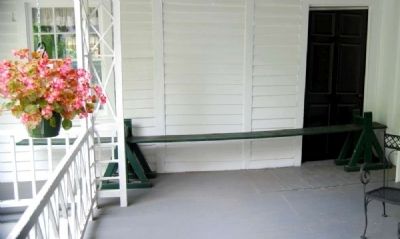
Photographed By Brian Scott, May 2, 2009
18. Joggling Board
Located on the back porch, the joggling board is a rare site in the Upstate. (One can only see another example at Ashtabula Plantation near Pendleton.) Popular in Charleston, joggling boards were used by children for play. Adults also used them to settle their stomachs after large meals by lightly bouncing up and down and also during courtship.
Davis, however, declined the offer.
Parker was later told that Davis and his party would leave that night. All of the men had horses for their journey. However, Parker did not and when he was unable to obtain a horse, he declined to go with them.
By midnight, Davis and his party resumed their flight and eventually came to “the house of the Rev. J. O. Lindsay, D. D., near Mt. Carmel,” where his wife was. The Davis’s then continued travelling, now into Georgia. By May 10, Davis was captured by Union Calvary in Irwinville, Ga.
Burt bought his Abbeville home in 1862. By 1868 however, the home was sold. James Samuel Stark bought the home in 1900. In 1971, his daughter, Mary Stark Davis, gave the house, and later the contents, to the Abbeville County Historical Preservation Commission.
The Burt-Stark Mansion is located at 400 N. Main St. in Abbeville. During the winter it is open on Friday and Saturday from 1 p.m. to 5 p.m. It is also open by special appointment if people call 459-4297. In the summer months, from May through Sept, the mansion is open Tuesday through Saturday from 1 p.m. to 5 p.m.
— Submitted August 21, 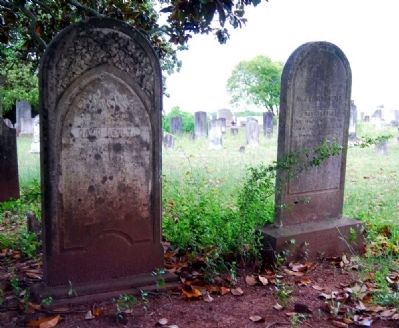 2008, by Brian Scott of Anderson, South Carolina.
2008, by Brian Scott of Anderson, South Carolina.

Photographed By Brian Scott, May 2, 2009
19. David and Louisa Lesly Tombstones
Upper Long Cane Cemetery, Abbeville, SC
Upper Long Cane Cemetery, Abbeville, SC
The original owners of the Burt-Stark Mansion. David Lesly (1797-1854), tombstone on the left; Louisa (no dates but age 65 at death) on the right. David Lesly inscription reads: "A member of the Presbyterian Church in which he was an elder for twenty-two years. The Bible was his guide, Christ his salvation."
5. The Last Hour by James E. Davis, Jr.
Nearing high noon on the 2nd day of May 1865, a Troop of Calvary dressed in Confederate Gray arrived at the Armistead Burt House in Abbeville. Major Burt, who was standing on the porch of his lovely home, held out his hand and clasped the extended hand of Jefferson Davis, President of the Confederate States of America. President Davis and his Cabinet, had left Richmond, Virginia after being told by General Robert E. Lee that Richmond would fall into the hands of Union Forces.
President Davis was weary from the long hours of being in the saddle and from the ever throbbing thoughts that the cause of the South was nearing its end. He was continuously trying to keep the spirits of his Cabinet and War Generals high but the look on their faces told him that they knew the "Last Hour" had arrived.
The President and his Cabinet freshened up and spent the afternoon resting. A pleasant meal was furnished by nearby neighbors who had heard that the distinguished guests were present at the Burt House. After the meal, the President, his Cabinet and War Generals retired to the drawing room.
Here the Cabinet tried to convince the President that due to lack of supplies and forces, it was futile to continue the war effort. President
Davis arose and firmly denied that all was lost. He contended that they should turn Westward after crossing into Georgia and cross over the Mississippi, there to join forces with Confederate Troops who were still in the field.
The Cabinet and War Generals strongly opposed this move, stating that to prolong the War would only cost the lives of more Southern men and that the end would be the same. Passionate pleas and heated words by the President failed to change the minds of the others. Finally (as the hour was drawing late) President Davis spoke to his Cabinet for the last time, asking them not to give up the cause but to follow him as they had done in the past. Being strongly committed to the Southern cause, he became emotional and tough he stood as tall and sturdy as an oak, his voice began to tremble and his eyes moistened. He expressed to each man present his gratitude for the service he had rendered on behalf of the South. He started toward the door -- tears had begun to moisten his bronze cheeks. His Cabinet and War Generals rose as one as their Chief passed among them. Judah Benjamin, standing nearest to the door, clasped the President's arm and led him out of the room. President Davis, having at this time covered his eyes with his handkerchief, allowed the man to lead him up the stairs to a bedroom.
Before dawn the next morning, May 3rd, the famous guests
of the Burts, arose, dressed, and breakfasted. Farewells and warm handshakes were extended by all.
Outside, the Confederate Gray stood stiffly awaiting the appearance of their Chief. Horses stamped their hoofs nervously and the clinking of bridles, sabres, and weapons could be heard in the stillness of the morning. The entrance door of the Burt House opened; the President walked out. His eyes moved slowly over his troops. A few hours before, they were soldiers of the Confederate States of America and had performed gallantly in many battles. Now the War was over for the Men in Gray. His troops would remain with him to see him safely out of the country. What could he say to them, these brave men who knew not the word "defeat"?
President Davis left the words unspoken. He moved to where a sentry held his horse. He placed his boot in the stirrup and swung himself into the saddle. He glanced back at the family who had been his host for the night, and although not a word was spoken, a smile ever so slight appeared on the President's face. With a gentle nod of his head, and a quick turn, he was gone.
The troops fell in behind him and with them they carried $500,000 in gold and the Seal of the Confederacy. It was their plan to cross the Savannah River by daylight.
They traveled down what is now known as the Mt. Carmel Road. A heavy rainfall delayed the
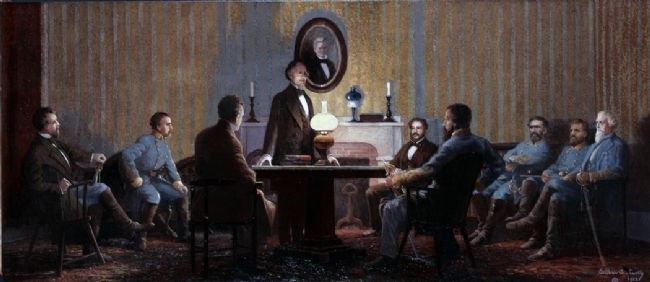
Photographed By Wilbur George Kurtz
22. The Last Council of War Meeting of Confederate President Jefferson Davis with his Military Advisors
One of a series of paintings by artist Wilbur George Kurtz depicting key events in the history of Abbeville. The table shown in the painting is one of the few items from the Burt era still in the house. Also present is the bed in which Davis spent the night.
Ironically, only several hundred yards from the Burt House on a hillside covered with beautiful oak and dogwood trees, was an equally historical spot that would in time become a kinship with the Burt House. This hill, known as Secession Hill since the date, November 22nd, 1860, was the location where a group of men gathered by invitation with an audience of 2000 to discuss Secession from the Union. Many dignitaries were present.
Therefore, Secession Hill became known as the "Birthplace of the Confederacy", and quite ironically, five years later, the Burt House became known as the "Deathbed of the Confederacy."
And so, Abbeville, as so many times before, had its moments in history. Many of the homes of that era still remain. The large oaks that once provided shade for President David and his men, continue to do so for the present generation.
As for President Davis: He passed this way -- never again -- but passed this way he did, and the house that until his arrival was only a home, now became a famous historical landmark.
— Submitted May 4, 2009, by Brian Scott of Anderson, South Carolina.
6. Armistead Burt (1802-1883)
Burt, Armistead, a Representative from South Carolina; born at Clouds Creek, near Edgefield, Edgefield District, S.C., November 13, 1802; moved with his parents to Pendleton, S.C.; completed preparatory studies; studied law; was admitted to the bar in 1823 and practiced in Pendleton; moved to Abbeville, S.C., in 1828 and continued the practice of law; also engaged in agricultural pursuits; member of the South Carolina house of representatives, 1834-1835, and 1838-1841; elected as a Democrat to the Twenty-eighth and to the four succeeding Congresses (March 4, 1843-March 3, 1853); chairman, Committee on Military Affairs (Thirty-first and Thirty-second Congresses); served as Speaker pro tempore of the House of Representatives during the absence of Speaker Winthrop in 1848; was not a candidate for renomination in 1852; resumed the practice of law in Abbeville; delegate to the Democratic National Convention in 1868; died in Abbeville, S.C., October 30, 1883; interment in Episcopal Cemetery. (Source: Biographical Directory of the U.S. Congress.)
— Submitted April 4, 2009, by Brian Scott of Anderson, South Carolina.
7. Jefferson Davis (1808–1889)
Jefferson Davis, (son-in-law of President Zachary Taylor), a Representative and a Senator from Mississippi; born in what is now Fairview, Todd County, Ky., June 3, 1808; moved with his parents to a plantation near Woodville, Wilkinson County, Miss.; attended the country schools, St. Thomas College, Washington County, Ky., Jefferson College, Adams County, Miss., Wilkinson County Academy, and Transylvania University, Lexington, Ky.; graduated from the United States Military Academy, West Point, N.Y., in 1828; served in the Black Hawk War in 1832; promoted to the rank of first lieutenant in the First Dragoons in 1833, and served until 1835, when he resigned; moved to his plantation, ‘Brierfield,’ in Warren County, Miss., and engaged in cotton planting; elected as a Democrat to the Twenty-ninth Congress and served from March 4, 1845, until June 1846, when he resigned to command the First Regiment of Mississippi Riflemen in the war with Mexico; appointed to the United States Senate to fill the vacancy caused by the death of Jesse Speight; subsequently elected and served from August 10, 1847, until September 23, 1851, when he resigned; chairman, Committee on Military Affairs (Thirtieth through Thirty-second Congresses); unsuccessful candidate for Governor in 1851; appointed Secretary of War by President Franklin Pierce 1853-1857; again elected as a Democrat to the United States Senate and served from March 4, 1857, until January 21, 1861, when he withdrew with other secessionist Senators; chairman, Committee on Military Affairs and the Militia (Thirty-fifth and Thirty-sixth Congresses); commissioned major general of the State militia in January 1861; chosen President of the Confederacy by the Provisional Congress and inaugurated in Montgomery, Ala., February 18, 1861; elected President of the Confederacy for a term of six years and inaugurated in Richmond, Va., February 22, 1862; captured by Union troops in Irwinsville, Ga., May 10, 1865; imprisoned in Fortress Monroe, indicted for treason, and was paroled in the custody of the court in 1867; returned to Mississippi and spent the remaining years of his life writing; died in New Orleans, La., on December 6, 1889; interment in Metairie Cemetery, New Orleans, La.; reinterment on May 31, 1893, in Hollywood Cemetery, Richmond, Va.; the legal disabilities placed upon him were removed, and he was posthumously restored to the full rights of citizenship, effective December 25, 1868, pursuant to a Joint Resolution of Congress (Public Law 95-466), approved October 17, 1978. (Source: Biographical Directory of the U.S. Congress.)
— Submitted November 12, 2009, by Brian Scott of Anderson, South Carolina.
8. John Cabell Breckinridge (1822-1875)
John Cabell Breckinridge, (grandson of John Breckinridge, father of Clifton Rodes Breckinridge, and cousin of Henry Donnel Foster), a Representative and a Senator from Kentucky and a Vice President of the United States; born at ‘Cabell’s Dale,’ near Lexington, Ky., January 16, 1821; attended Pisgah Academy, Woodford County, Ky.; graduated from Centre College, Danville, Ky., in 1839; later attended the College of New Jersey (now Princeton University); studied law in the Transylvania Institute, Lexington, Ky.; admitted to the bar in 1840; moved to Burlington, Iowa, but soon returned and began practice in Lexington, Ky.; major of the Third Kentucky Volunteers during the Mexican War in 1847 and 1848; member, State house of representatives 1849; elected as a Democrat to the Thirty-second and Thirty-third Congresses (March 4, 1851-March 3, 1855); was not a candidate for renomination in 1854; was tendered the mission to Spain by President Franklin Pierce, but declined; elected Vice President of the United States in 1856 on the Democratic ticket with James Buchanan as President; unsuccessful candidate for President in 1860; elected to the United States Senate and served from March 4, 1861, until expelled by resolution of December 4, 1861, for support of the rebellion; entered the Confederate Army during the Civil War as brigadier general and soon became a major general;
Secretary of War in the Cabinet of the Confederate States from January until April 1865; resided in Europe until 1868; returned to Lexington, Ky., and resumed the practice of law; vice president of the Elizabethtown, Lexington Big Sandy Railroad Co.; died in Lexington, Ky., May 17, 1875; interment in Lexington Cemetery. (Source: Biographical Directory of the U.S. Congress.)
— Submitted November 15, 2009, by Brian Scott of Anderson, South Carolina.
9. John Henninger Reagan (1818-1905)
John Henninger Reagan, a Representative and a Senator from Texas; born in Sevierville, Sevier County, Tenn., October 8, 1818; attended the common schools and private academies; moved to Texas in 1839, joined the republic’s army, and participated in campaigns against the Cherokee Indians; deputy State surveyor of the public lands 1839-1843; studied law; admitted to the bar in 1848 and practiced in Buffalo and Palestine, Tex.; member, State house of representatives 1847-1849; judge of the district court 1852-1857, when he resigned; elected as a Democrat to the Thirty-fifth and Thirty-sixth Congresses (March 4, 1857-March 3, 1861); elected to the secession convention of Texas in 1861; deputy to the Provisional Congress of the Confederacy; postmaster general of the Confederacy from 1861 until the close
of the war; also appointed Acting Secretary of the Treasury of the Confederacy for a short time preceding the close of the war; imprisoned at Fort Warren for several months after the war; member of the State constitutional convention in 1875; elected as a Democrat to the Forty-fourth and to the five succeeding Congresses (March 4, 1875-March 3, 1887); had been reelected to the Fiftieth Congress but resigned March 4, 1887, to become Senator; chairman, Committee on Commerce (Forty-fifth, Forty-sixth, Forty-eighth, and Forty-ninth Congresses); elected as a Democrat to the United States Senate and served from March 4, 1887, until June 10, 1891, when he resigned; returned to Texas and was appointed a member of the railroad commission of the State and served as chairman 1897-1903; died in Palestine, Anderson County, Tex., March 6, 1905; interment in East Hill Cemetery. (Source: Biographical Directory of the U.S. Congress.)
— Submitted November 15, 2009, by Brian Scott of Anderson, South Carolina.
10. William Campbell Preston Breckinridge (1837–1904)
William Campbell Preston Breckinridge, (grandson of John Breckinridge, uncle of Levin Irving Handy, and great-uncle of John Bayne Breckinridge), a Representative from Kentucky; born in Baltimore, Md., August 28, 1837; attended the
common schools, Jefferson College, Chambersburg, Pa., and Pisgah Academy, Woodford County, Ky.; was graduated from Centre College, Danville, Ky., in 1855 and from the law department of the University of Louisville in 1857; was admitted to the bar in 1857 and commenced practice in Lexington, Ky.; entered the Confederate Army in 1861 as captain and was subsequently promoted to the rank of colonel in the Ninth Kentucky Cavalry; was in command of the Kentucky cavalry designated to act as bodyguard for President Jefferson Davis and the members of his cabinet at the close of the Civil War; returned to Lexington, Ky., and was attorney for Fayette County; edited the Lexington (Ky.) Observer and Reporter 1866-1868; professor of equity and jurisprudence in the University of Kentucky at Lexington; delegate to the Democratic National Conventions in 1876 and 1888; elected as a Democrat to the Forty-ninth and to the four succeeding Congresses (March 4, 1885-March 3, 1895); unsuccessful candidate for election in 1896 to the Fifty-fifth Congress; resumed the practice of law and also edited the Lexington Herald; died in Lexington, Ky., November 18, 1904; interment in Lexington Cemetery. (Source: Biograpical Directory of the U.S. Congress.)
— Submitted November 15, 2009, by Brian Scott of Anderson, South Carolina.
11. George Gibbs Dibrell
George Gibbs Dibrell, a Representative from Tennessee; born in Sparta, White County, Tenn., April 12, 1822; attended the public schools, and was graduated from the East Tennessee University, Knoxville, Tenn., in 1843; studied law; was admitted to the bar in 1843 and practiced; engaged in agricultural and mercantile pursuits; justice of the peace and county court clerk of White County, Tenn., for many years; member, State house of representatives, 1861; volunteered in the Confederate Army and served from 1861 to 1865; rose from private to lieutenant colonel of Infantry and colonel of Cavalry, and was discharged as brigadier general; delegate to the State’s constitutional convention in 1870; elected as a Democrat to the Forty-fourth and to the four succeeding Congresses (March 4, 1875-March 3, 1885); was not a candidate for renomination in 1884; resumed agricultural and mercantile pursuits; died in Sparta, Tenn., May 9, 1888; interment in the Old Sparta Cemetery. (Source: Biographical Directory of the U.S. Congress.)
— Submitted November 15, 2009, by Brian Scott of Anderson, South Carolina.
12. Obituary of Martha Calhoun Burt
Abbeville Press
Friday, April 2, 1869
Died, on the morning of the 27th of March last, after a long and painful illness, Martha Calhoun Burt, wife of Hon. Armistead BURT, in the 58th year of her age. Mrs. Burt was the daughter of William Calhoun of the Calhoun settlement in the district of Abbeville. She was of that family which came early to this region and being distinguished among their neighbors, gave their name to the locality where they lived. Mrs. Burt was born and raised in Abbeville. After she married, her husband being a lawyer in practice in this village, she resided here until Mr. Burt was elected to Congress in 1842 after which event she spent much time in Washington City, where she lived near her uncle Hon. John C. Calhoun, until Mr. Burt voluntarily retired and returned to Abbeville.
After residing several years at Orange Hill plantation on the Savannah River, Mr. Burt returned again to Abbeville where Mrs. Burt died, and amidst a large concourse of sympathizing friends, was buried at the cemetery of Trinity church, Sunday last, Easter Day.
One by one, the lights of the past are going out and it is painfully certain that the tendency of the times exclude the probability of their places being filled. Mrs. Burt was an accomplished lady of the old school. Sprung from a family distinguished for wealth, intelligence and position and possessing high personal qualities, she was educated before the age of economists and calculators. She united the highest
breeding with the utmost frankness and cordiality of manner. No mistress was every kinder to servants and dependents. Always particularly affable to the young and inexperienced, she was the leader in every circle in which she moved whether in the quiet, refined society or her native district, or among the distinguished orators and statesman, who were delighted to surround her in Washington. This community will long retain the impress of her brilliancy and culture and her friends will never forget her many virtues and warm hearted friendships.
After an unbroken companionship for more than forty years, her death leaves her husband desolate indeed; but that desolation may be alleviated by recalling the devotion of the departed one, and by the consciousness of a life time spent in unceasing efforts to make her comfortable and happy. For many years, a consistent member of the Episcopal church, in her last illness she gave evidence of a well founded hope beyond the grave; and as they were united in life and united in the church, the bereaved husband may look forward to a happy reunion hereafter.
— Submitted November 14, 2008, by Brian Scott of Anderson, South Carolina.
13. Marker Style
The marker shown reflects the second style of South Carolina Historical Markers. It was
in use between 1955 and 1990. The original design was cast aluminum and crowned with a bas relief of the state flag surrounded by an inverted triangle. The markers were painted dark blue with silver lettering.
— Submitted September 16, 2008, by Brian Scott of Anderson, South Carolina.
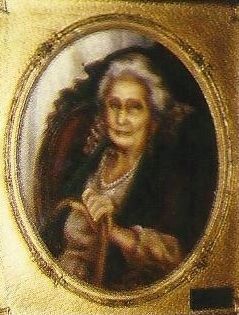
Photographed By Brian Scott
41. Mary Stark Davis
1885-1897
1885-1897
Mary Stark Davis agreed in 1971 to donate her historic home to a properly formed public body so as to preserve it for future generations. To that end, the Abbeville County Historic Preservation Commission was established and its members appointed by Governor Robert McNain at the recommendation of the legislative delegation. In 1976 Mrs. Davis donated the contents of the house as well. Until her death in 1987 at 102, "Miss Mary," as she was fondly and widely known, was a gracious hostess to countless groups, tours, and official functions in her elegant home.
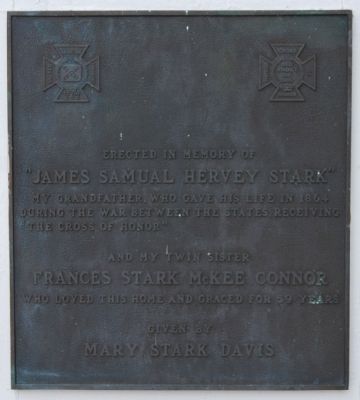
Photographed By Brian Scott, December 23, 2008
42. James Samuel Hervey Stark Plaque
Located on the Front Porch
Located on the Front Porch
James Samuel Hervey Stark
my grandfather who gave his life in 1864
during the War Between the States, receiving
"the Cross of Honor"
and my twin sister
Frances Stark McKee Connor
who loved this home and graced for 59 years
Given by
Mary Stark Davis
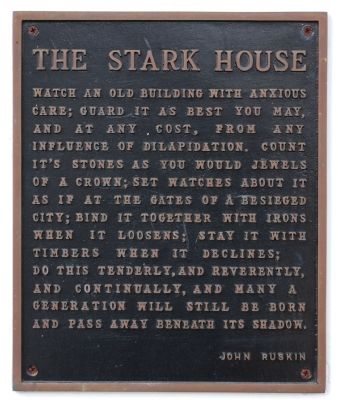
Photographed By Brian Scott, December 23, 2008
43. The Stark House
care; guard it as best you may,
and at any cost, from any
influence of dilapidation. Count
it's stones as you would jewels
of a crown; set watches about it
as if at the gates of a besieged
city; bind it together with irons
when it loosens; stay it
with timbers when it declines;
at this tenderly, and reverently,
and continually, and many a
generation will still be born
and pass away beneath its shadow.
John Ruskin
Credits. This page was last revised on December 9, 2021. It was originally submitted on April 17, 2008, by Brian Scott of Anderson, South Carolina. This page has been viewed 12,504 times since then and 135 times this year. Last updated on August 21, 2008, by Brian Scott of Anderson, South Carolina. Photos: 1, 2. submitted on April 17, 2008, by Brian Scott of Anderson, South Carolina. 3. submitted on December 25, 2008, by Brian Scott of Anderson, South Carolina. 4. submitted on August 5, 2008, by Brian Scott of Anderson, South Carolina. 5. submitted on November 12, 2009, by Brian Scott of Anderson, South Carolina. 6. submitted on October 5, 2008, by Brian Scott of Anderson, South Carolina. 7. submitted on April 18, 2008, by Brian Scott of Anderson, South Carolina. 8. submitted on November 14, 2008, by Brian Scott of Anderson, South Carolina. 9, 10. submitted on December 25, 2008, by Brian Scott of Anderson, South Carolina. 11, 12. submitted on May 21, 2012, by Brian Scott of Anderson, South Carolina. 13, 14. submitted on December 25, 2008, by Brian Scott of Anderson, South Carolina. 15. submitted on November 14, 2009, by Brian Scott of Anderson, South Carolina. 16. submitted on May 4, 2009, by Brian Scott of Anderson, South Carolina. 17. submitted on November 12, 2009, by Brian Scott of Anderson, South Carolina. 18, 19. submitted on May 4, 2009, by Brian Scott of Anderson, South Carolina. 20. submitted on April 21, 2009, by Patricia C Borders of Bakersfield, California. 21. submitted on December 27, 2010, by Brian Scott of Anderson, South Carolina. 22. submitted on December 25, 2008, by Brian Scott of Anderson, South Carolina. 23. submitted on July 27, 2014, by Brian J. Scott of Spartanburg, South Carolina. 24. submitted on November 12, 2009, by Brian Scott of Anderson, South Carolina. 25, 26. submitted on November 13, 2009, by Brian Scott of Anderson, South Carolina. 27. submitted on December 25, 2008, by Brian Scott of Anderson, South Carolina. 28. submitted on November 14, 2008, by Brian Scott of Anderson, South Carolina. 29, 30, 31, 32. submitted on November 15, 2008, by Brian Scott of Anderson, South Carolina. 33, 34, 35, 36, 37, 38. submitted on November 14, 2009, by Brian Scott of Anderson, South Carolina. 39, 40. submitted on April 22, 2009, by Brian Scott of Anderson, South Carolina. 41. submitted on May 21, 2012, by Brian Scott of Anderson, South Carolina. 42, 43. submitted on December 25, 2008, by Brian Scott of Anderson, South Carolina. • Craig Swain was the editor who published this page.
